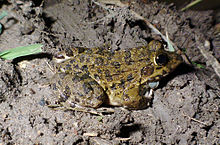Hoplobatrachus crassus
| Hoplobatrachus crassus | |
|---|---|

| |
| Scientific classification | |
| Domain: | Eukaryota |
| Kingdom: | Animalia |
| Phylum: | Chordata |
| Class: | Amphibia |
| Order: | Anura |
| Family: | Dicroglossidae |
| Genus: | Hoplobatrachus |
| Species: | H. crassus |
| Binomial name | |
| Hoplobatrachus crassus (Jerdon, 1854) | |
| Synonyms[2] | |
|
Rana malabarica Kelaart, 1853 – junior homonym of Rana malabarica Tschudi, 1838 | |
Hoplobatrachus crassus, also called Jerdon's bullfrog, Jerdon's bull frog, and South Indian bullfrog, is a species of frog found widely distributed on the plains of India, Bangladesh, Nepal, and Sri Lanka. Its range may extend to the adjacent Bhutan and Myanmar.[2]
Description
This species has a shovel shaped metatarsal tubercle and has longer hind legs than the somewhat similar H. tigrinus with which it overlaps in part of its range. When the leg is stretched along the body the tibio-tarsal (ankle) joint lies at a position between the ear and eye. Females are slightly larger than males (about 8–10 cm or more while males are about 5–8 cm).[3][4]
Habitat and ecology
Hoplobatrachus crassus is a terrestrial frog that lives in seasonally flooded dry grasslands, open plains and arid areas, also in cultivated areas and near human settlements. Adult frogs are often found in burrows. They may aestivate during dry periods. Breeding takes place in water.[1] Males have two vocal sacs on the side and the call sounds somewhat like a bleating goat. The calls last for a few minutes and consist of 2 to 4 series of 13–18 bleating pulses. They breed with the onset of the rains.[5]
The species is able to tolerate salinity to some extent. They tolerate 25% natural sea-water (25 parts of sea-water diluted with 75 parts of distilled water) but do not live for more than a week when the salinity goes up to the strength of 35% natural sea-water (sea water itself being about 32 parts per thousand).[6] Their tadpoles are thought to feed on algae.[7] A ciliate in the genus Cepedea has been recorded living in tadpoles of this species.[8]
References
- ^ a b Anand Padhye, Kelum Manamendra-Arachchi, Anslem de Silva, Sushil Dutta, Tej Kumar Shrestha, Sabitry Bordoloi (2004). "Hoplobatrachus crassus". IUCN Red List of Threatened Species. 2004: e.T58298A11754703. doi:10.2305/IUCN.UK.2004.RLTS.T58298A11754703.en. Retrieved 19 November 2021.
{{cite journal}}: CS1 maint: multiple names: authors list (link) - ^ a b Frost, Darrel R. (2017). "Hoplobatrachus crassus (Jerdon, 1853)". Amphibian Species of the World: an Online Reference. Version 6.0. American Museum of Natural History. Retrieved 6 January 2018.
- ^ Bhaduri, Jnanendra Lal (1944). "A note on Rana crassa Jerdon, with extension of its range". Journal of the Bombay Natural History Society. 44 (3): 481–483.
- ^ Dutta, S. K.; Mahapatra, P.; Mohanty-Hejmadi, P. (1991). "Size analysis and sex ratio of Jerdon's bull Frog Rana crassa Jerdon (Anura: Ranidae)". Journal of the Bombay Natural History Society. 88 (2): 234–241.
- ^ Kanamadi R.D.; Hiremath C.R.; Schneider H. (1992). "Vocalization and breeding period in the south indian tropical frog Rana crassa Jerdon". Zoologischer Anzeiger. 228 (12): 26–31.
- ^ Chakko, George (1968). "Salinity tolerances in some south Indian anurans" (PDF). Proceedings of the Indian Academy of Sciences. Section B. 67 (5): 233–236. doi:10.1007/BF03053907. S2CID 80873923.
- ^ Das, Indraneil (1994). "The internal oral morphology of some anuran larvae from south India: a scanning electron microscopic study" (PDF). Amphibia-Reptilia. 15 (3): 249–256. doi:10.1163/156853894X00029.
- ^ Metcalf, Maynard M. (1940). "Further studies on the opalinid ciliate infusorians and their hosts". Proceedings of the United States National Museum. 87 (3077): 465–634. doi:10.5479/si.00963801.87-3077.465.

